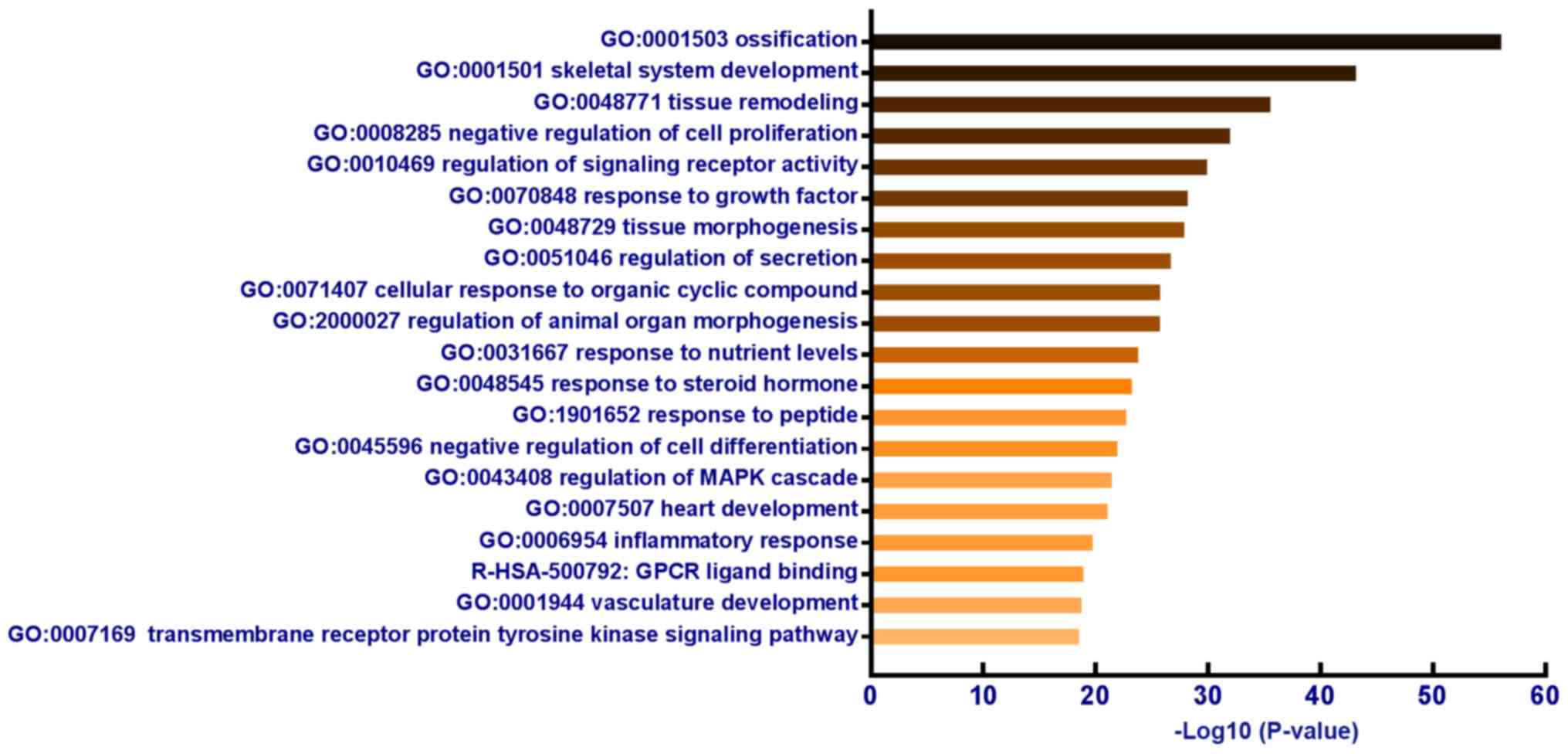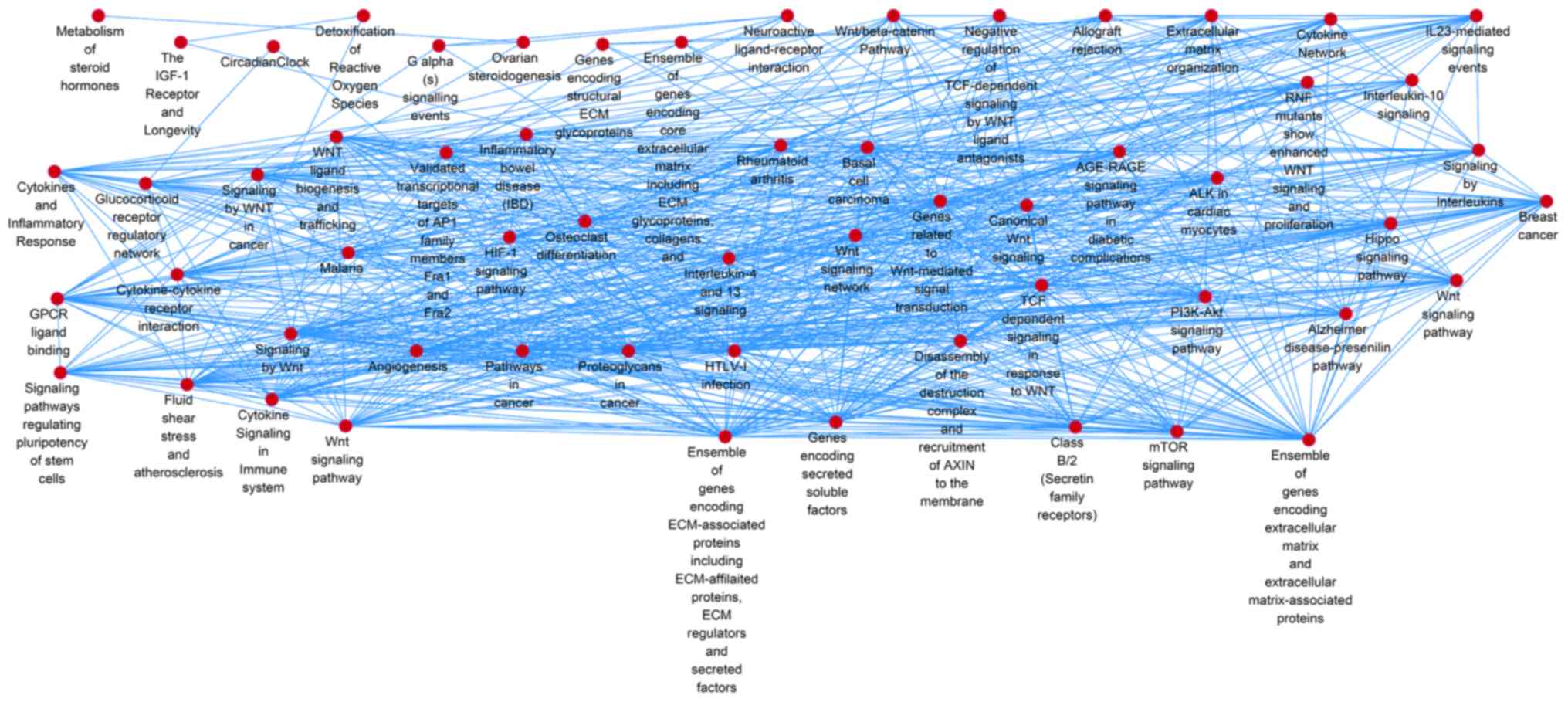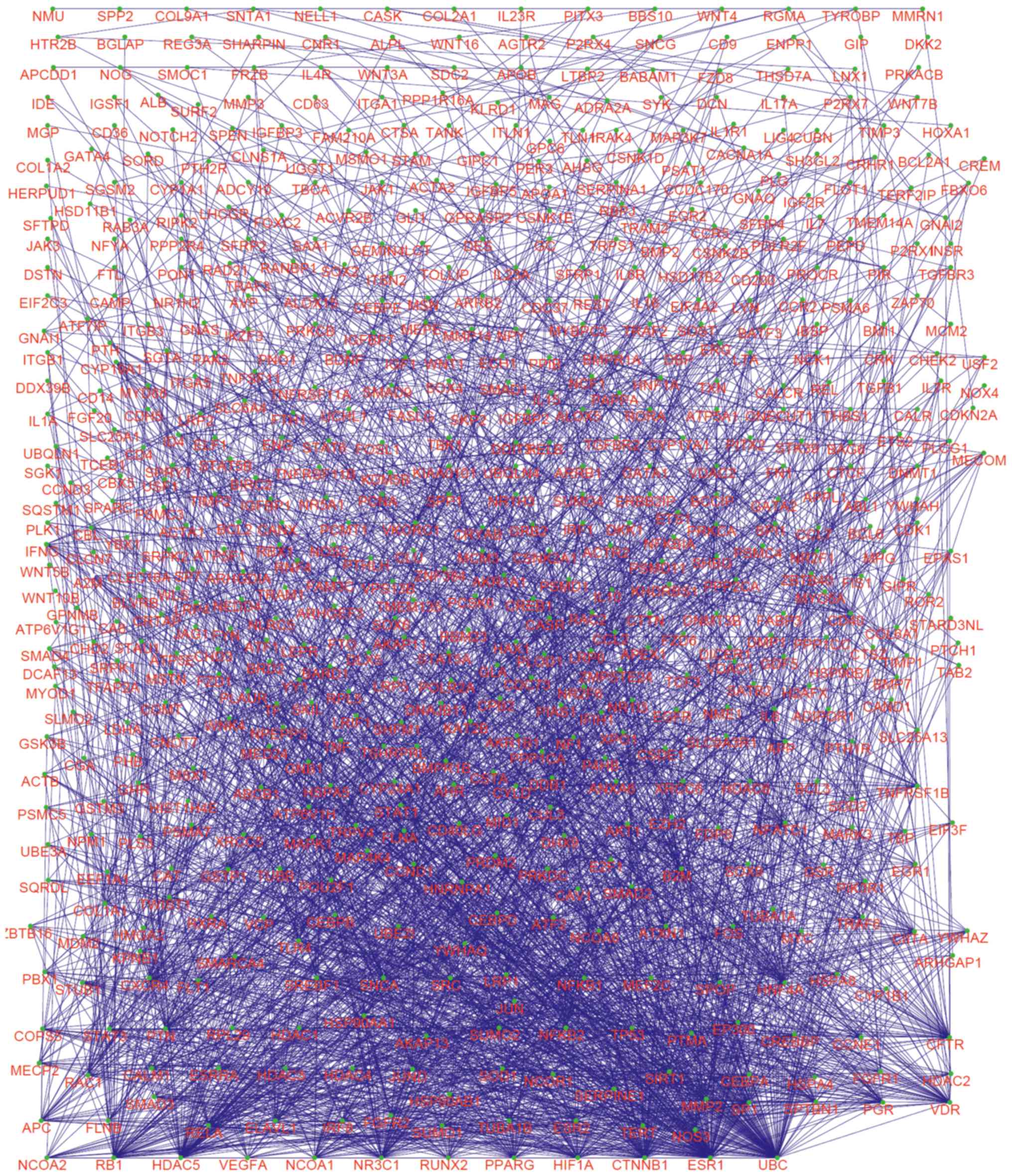| ADRA2A, JAG1,
AGTR2, AKR1B1, ALOX5, ALOX15, ALPL, ANXA6, APC, ARHGAP1, ATP5E,
AVP, B2M, BDNF, BGLAP, BLVRB, BMP2, BMP7, BMPR1B, CA8, CALCR, CASR,
CAT, RUNX2, CCNE1, CD40, CD40LG, CFTR, CHD2, CLCN7, CNR1, COL1A1,
COL6A1, COL9A1, COMT, CPB2, CRHR1, CSTA, CTNNB1, CTSZ, CYLD,
CYP1A1, CYP1B1, CYP17A1, CYP19A1, CYP24A1, DBP, DLX5, DMP1, ESR1,
ESR2, ESRRA, MECOM, FABP3, FDPS, FGFR1, FGFR2, FOXC2, FLNB, FLT1,
FRZB, GC, MSTN, GHR, GIP, GIPR, GLA, NR3C1, GSR, GSTM3, GSTP1,
HIF1A, HSD11B1, HSD17B2, HTR2B, IBSP, IRF8, ID4, IFNG, IGF1,
IGFBP2, IL1A, IL6, IL6R, IL7, IL10, IL15, IL16, IL17A, ITGA1, JUND,
LCT, LEPR, LHCGR, LRP1, LRP4, LRP6, LRP5, LTA, LTBP2, MARK3, MECP2,
MEF2C, MGP, CIITA, MID1, MMP2, CD200, MSX1, MYO5A, NELL1, NF1,
NFATC1, NFKB2, NOS3, NPY, ROR2, TNFRSF11B, P2RX1, P2RX4, P2RX7,
PCSK6, SERPINE1, REG3A, PAPPA, PBX1, ENPP1, PGR, ABCB1, PLAUR,
PLOD1, PLS3, PON1, PPARG, PRL, PTCH1, PTH, PTHLH, PTH1R, PTH2R,
PTMA, PTN, RAC1, RAC2, RB1, BRD2, RPL29, SAA1, ATXN1, CCL2, SFRP1,
SFRP2, SFRP4, SHBG, SLC6A4, SNCA, SOD1, SOD2, SOX4, SOX9, SPARC,
SPP2, SPP1, SPTBN1, SREBF1, TERT, TGFBR3, TIMP1, TIMP2, TLR4,
TNFRSF1B, TRPS1, TSHR, TWIST1, TYROBP, VDR, VEGFA, WNT1, WNT7B,
WNT10B, PRDM2, CSDE1, CXCR4, SHFM1, HMGA2, GDF5, FZD1, FZD6, SPOP,
PIR, TNFSF11, NCOA1, TNFRSF11A, PER3, NOG, MAP4K4, ATP6V1G1, TRAM2,
ZBTB40, NR1I3, HDAC5, GPC6, SLC25A13, SPRY1, ZMPSTE24, AKR1A1,
TUBA1B, FAM3C, GPNMB, CRTAP, NCOA2, NMU, AKAP13, AKAP11, MMRN1,
DKK1, CLEC16A, SATB2, DICER1, DCAF13, FGF20, DKK2, TMEM14A, CNOT7,
NOX4, ARHGEF3, SOST, SLMO2, ADIPOR1, WNT16, IL23A, ATP6V1H, SOX6,
ITLN1, ADCY10, MEPE, RGMA, SQRDL, TRPV4, SMOC1, IFIH1, TMEM135,
WNK4, VKORC1, FTO, WLS, CCDC170, WNT5B, STARD3NL, NLRC5, WNT3A,
SP7, FAM210A, IL23R, VPS13B, ZNF384, THSD7A, NCF1, CCR2 |
|
| B, Genes
included in OS-specific network but not in OSgest |
|
| UBC, HNF4A, SP1,
ELAVL1, EP300, SUMO2, CXR4, RELA, CREBBP, SUMO1, STAT3, HSP90AA1,
TP53, SMAD3, SRC, HDAC1, APP, SIRT1, JUN, EGR1, COPS5, TRAF6,
SMAD2, GRB2, PIK3R1, YWHAZ, SMARCA4, MYC, HSP90AB1, NFKB1, STAT1,
CALM1, HDAC3, HSPA8, HDAC4, E2F1, STUB1, CEBPB, YWHAQ, FOS, CUL3,
HDAC2, RXRA, CAV1, CREB1, NCOR1, CEBPA, MDM2, KAT2B, GSK3B, SMAD4,
CEBPD, IRF1, POU2F1, YY1, FN1, HSPA4. ATF2, A2M, KPNB1, HNF1A,
UBE2I, XRCC5, NOS2, MAPK1, SUMO4, NCOA6, ZBTB16, VCP, KIAA0101,
NCK1, TCF3, PLCG1, FYN, H2AFX, HDAC6, EPAS1, ACTB, CANX, HSPA5,
EEF1A1, TUBB, TUBA1A, FLNA, SPI1, ETS1, NEDD4, AKT1, CCND1, PRKDC,
EZH2, XRCC6, TBP, PPP2CA, XPO1, BCL6, PIAS1, REL, CRK, HNRNPA1,
DNMT1, UBE3A, CBL, TRAF3, PRKCA, IL7R, TFAP2A, TRAF2, PSMC5, USF1,
TNF, PPP1CA, HIST1H4E, MYOD1, STAT5A, VDAC1, PSMC4, MED24, BIRC2,
NPM1, STAT5B, UBQLN1, CDK1, ITGB1, SLC9A3R1, FBXO6, SMAD1, PLK1,
EIF3F, BCL3, ONECUT1, CAND1, PSMD1, PSMA7, AHR, DHX9, BAG6, ABL1,
SQSTM1, DDB1, PHB, THBS1, SMAD9, PAK2., STAT6, NME1, RPL5, NPEPPS,
CRYAB, DDIT3, PPP1CC, P4HB, NR2F1, APEX1, HSP90B1, GNAI1, CD4,
CSNK2A1, UBQLN4, PCMT1, DNMT3B, RBX1, USF2, FOSL1, MCM3, POLR2F,
PSMD11, LDHA, SKIL, ITGA5, BMPR1A, PITX3, NR5A1, DNAJB11, YWHAH,
PSMC3, CBX5, CCND3, BCL2, CGA, LRIF1, KHDRBS1, CACNA1A, CDC73,
NFKBIA, SNTA1, ARHGDIA, SRPK1, ENG, CCL7, RAD21, NR2F6, MPG, HAX1,
TAB2, CALR, PCNA, STAU1. GATA1, BCCIP, CLU, SGTA, SKP2, TF, RELB,
NFYA, RORA, FTH1, PSMA6, VDAC2, POLR2A, ERBB2IP, MYD88, PEPD, JAK1,
PPP2R4, ATF1, GATA2, CHD3, ARRB1, TBK1, ELF1, PLG, NR1H3, GNB1,
CTCF, YBX1, MAP3K7, ACVR2B, ETS2, IGFBP1, FZD8, SORD, CHEK2, LNX1,
ATP5F1, ZAP70, ACTA1, MAG, PNO1, TGFB1, ACTR2, PPIB, FIS1, ERG,
TGFBR2, GIPC1, ATP5A1, TERF2IP, TOLLIP, ACTA2, TRAM1, SGK1, MMP14,
PRKCB, PROCR, IGFBP5, MSN, CEBPE, CSNK1E, KDM5B, RANBP1, STK39,
CTTN, BARD1, ARRB2, APPL1, FLOT1, JAK3, CD14, FASLG, WNT4, RIPK2,
CLNS1A, SRPK2, PITX2, MCM2, EGFR, CSNK2B, ATF7IP, EIF2C3, APOA1,
RBM23, GEMIN4, BATF3, SLC25A1, CCR5, TXN, LYN, GNAI2, ALB, RNF4,
SOX2, CDC37, TCEB1, INSR, FTL, CSNK1D, SYK, TBCA, CD63, BABAM1,
NR1H2, TIMP3, IGFBP3, UGGT1, COL2A1, PSAT1, EIF4A2, UCHL1, SPEN,
STAM, IGF2R, SGSM2, GNAS, IRAK4, ECH1, IL1R1, CD9, KLRD1, LIG4,
SERPINA1, MSMO1, LRP2, CAMP, IL4R, GPRASP2, SHARPIN, REST, COL1A2,
PPP1R16A, TLN1, AHSG, RAB3A, CUBN, IGSF1, SFTPD, SDC2, DCN, GNAQ,
HERPUD1, APOB, HOXA1, IGFBP7, ITSN2, TANK, DDX39B, BBS10, GATA4,
IDE, ITGB3, SNCG, CDH5, CREM, BMI1, DSTN, BCL2A1, CDKN2A, CTSA,
CD36, CASK, MMP3, EGR2, NOTCH2, PRKACB, SURF2, DES, MYBPC2, IKZF3,
RBPJ, SH3GL2, GLI1, APCDD1 |
|
| C, Genes in the
main module extracted from the OS specific network |
|
| A2M, AHR, AKT1,
APC, BIRC2, ARRB1, ATF1, B2M, CCND1, BCL3, BCL6, CALM1, CAV1,
RUNX2, CCNE1, CD14, CD40, CDK1, CEBPA, CEBPB, CEBPD, CFTR, CLU,
CCR5, CREB1, ATF2, CREBBP, CREM, CSNK2A1, CTNNB1, CYP19A1, CYP24A1,
DDB1, DHX9, E2F1, EEF1A1, EGFR, EGR1, ELF1, EP300, EPAS1, NR2F6,
ESR1, ESR2, ESRRA, ETS1, ETS2, MECOM, FLNA, FOS, FTH1, NR5A1,
XRCC6, GATA2, NR3C1, GSK3B, HDAC1, HDAC2, HIF1A, HNRNPA1, HSPA4,
HSPA5, HSPA8, HSP90AA1, HSP90AB1, IRF8, IFNG, RBPJ, IL6, IL10,
IL16, IRF1, JUN, JUND, KPNB1, LRP4, LTA, SMAD2, SMAD3, SMAD4,
MARK3, MCM3, MDM2, MECP2, MEF2C, CIITA, MID1, MMP2, CD200, MYC,
MYO5A, MYOD1, NF1, NFATC1, NFKB1, NFKB2, NME1, NOS2, NOS3, NPM1,
P2RX1, P4HB, SERPINE1, PBX1, PCNA, PGR, PHB, POLR2A, POU2F1, PPARG,
PPP2CA, PRKDC, MAPK1, PRL, PSMA6, PSMA7, PSMC3, PSMC4, PSMC5,
PSMD1, PSMD11, PTHLH, PTH1R, PTMA, RB1, REL, RELA, RNF4, RXRA,
ATXN1, CCL2, CCL7, SFTPD, SGK1, SKP2, SMARCA4, SUMO2, SNCA, SOD1,
SOD2, SOX4, SOX9, SP1, SPI1, SPTBN1, SRC, SREBF1, STAT1, STAT5A,
STAT6, TBP, TCF3, TERT, TFAP2A, TLR4, TNF, TNFRSF1B, TP53, HSP90B1,
TRPS1, TWIST1, UBE2I, UBE3A, SUMO1, USF1, USF2, VCP, VDAC1, VDAC2,
VDR, VEGFA, XPO1, XRCC5, YY1, YWHAH, YWHAZ, ZBTB16, PRDM2, TUBA1A,
CXCR4, SHFM1, FOSL1, HIST1H4E, PIAS1, NCOA1, EIF3F, RIPK2, HDAC3,
KAT2B, SLC9A3R1, NCOR1, HDAC4, MED24, NR1I3, RBX1, HDAC6, HDAC5,
NR1H3, STUB1, TUBA1B, HAX1, NCOA2, CTCF, YWHAQ, COPS5, NCOA6, TAB2,
SIRT1, FGF20, TBK1, NOX4, WNT16. SOX6, CAND1, UGGT1, UBQLN4, SQRDL.
WNK4, TUBB |

















